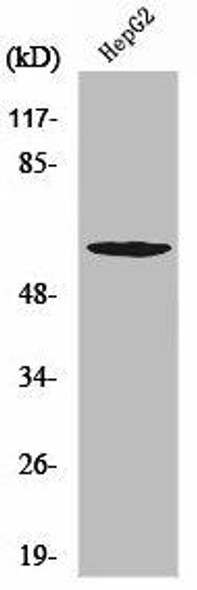KCNA5 Antibody (PACO14616)
- SKU:
- PACO14616
- Product type:
- Antibody
- Reactivity:
- Human
- Mouse
- Rat
- Host Species:
- Rabbit
- Isotype:
- IgG
- Application:
- ELISA
- Application:
- WB
- Antibody type:
- Polyclonal
- Conjugation:
- Unconjugated
Description
| Antibody Name: | KCNA5 Antibody (PACO14616) |
| Antibody SKU: | PACO14616 |
| Size: | 50ul |
| Host Species: | Rabbit |
| Tested Applications: | ELISA, WB |
| Recommended Dilutions: | ELISA:1:2000-1:5000, WB:1:500-1:2000 |
| Species Reactivity: | Human, Mouse, Rat |
| Immunogen: | Fusion protein of human KCNA5 |
| Form: | Liquid |
| Storage Buffer: | -20°C, pH7.4 PBS, 0.05% NaN3, 40% Glycerol |
| Purification Method: | Antigen affinity purification |
| Clonality: | Polyclonal |
| Isotype: | IgG |
| Conjugate: | Non-conjugated |
 | Gel: 10%SDS-PAGE, Lysate: 40 μg, Lane: Mouse spleen tissue, Primary antibody: PACO14616(KCNA5 Antibody) at dilution 1/700, Secondary antibody: Goat anti rabbit IgG at 1/8000 dilution, Exposure time: 60 seconds. |
| Background: | Potassium channels represent the most complex class of voltage-gated ino channels from both functional and structural standpoints. Their diverse functions include regulating neurotransmitter release, heart rate, insulin secretion, neuronal excitability, epithelial electrolyte transport, smooth muscle contraction, and cell volume. Four sequence-related potassium channel genes - shaker, shaw, shab, and shal - have been identified in Drosophila, and each has been shown to have human homolog(s). This gene encodes a member of the potassium channel, voltage-gated, shaker-related subfamily. This member contains six membrane-spanning domains with a shaker-type repeat in the fourth segment. It belongs to the delayed rectifier class, the function of which could restore the resting membrane potential of β cells after depolarization and thereby contribute to the regulation of insulin secretion. This gene is intronless, and the gene is clustered with genes KCNA1 and KCNA6 on chromosome 12. Defects in this gene are a cause of familial atrial fibrillation type 7 (ATFB7). |
| Synonyms: | potassium voltage-gated channel, shaker-related subfamily, member 5 |
| UniProt Protein Function: | Kv1.5: Mediates the voltage-dependent potassium ion permeability of excitable membranes. Assuming opened or closed conformations in response to the voltage difference across the membrane, the protein forms a potassium-selective channel through which potassium ions may pass in accordance with their electrochemical gradient. This channel displays rapid activation and slow inactivation. May play a role in regulating the secretion of insulin in normal pancreatic islets. Isoform 2 exhibits a voltage-dependent recovery from inactivation and an excessive cumulative inactivation. Defects in KCNA5 are the cause of familial atrial fibrillation type 7 (ATFB7). Atrial fibrillation is a common disorder of cardiac rhythm that is hereditary in a small subgroup of patients. It is characterized by disorganized atrial electrical activity, progressive deterioration of atrial electromechanical function and ineffective pumping of blood into the ventricles. It can be associated with palpitations, syncope, thromboembolic stroke, and congestive heart failure. Belongs to the potassium channel family. A (Shaker) (TC 1.A.1.2) subfamily. Kv1.5/KCNA5 sub-subfamily. 2 isoforms of the human protein are produced by alternative splicing. |
| UniProt Protein Details: | Protein type:Membrane protein, integral; Channel, potassium; Membrane protein, multi-pass Chromosomal Location of Human Ortholog: 12p13 Cellular Component: Golgi apparatus; voltage-gated potassium channel complex; intracellular canaliculus; perinuclear region of cytoplasm; integral to plasma membrane; endoplasmic reticulum; plasma membrane; caveola; Z disc; lipid raft Molecular Function:protein binding; outward rectifier potassium channel activity; delayed rectifier potassium channel activity; alpha-actinin binding; potassium channel inhibitor activity; protein kinase binding; receptor binding Biological Process: synaptic transmission; regulation of membrane potential; regulation of potassium ion transport; reduction of cytosolic calcium ion concentration; regulation of vasoconstriction; negative regulation of potassium ion transport; membrane hyperpolarization; response to hypoxia; potassium ion homeostasis; regulation of insulin secretion; potassium ion transport; protein homooligomerization Disease: Atrial Fibrillation, Familial, 7 |
| NCBI Summary: | Potassium channels represent the most complex class of voltage-gated ino channels from both functional and structural standpoints. Their diverse functions include regulating neurotransmitter release, heart rate, insulin secretion, neuronal excitability, epithelial electrolyte transport, smooth muscle contraction, and cell volume. Four sequence-related potassium channel genes - shaker, shaw, shab, and shal - have been identified in Drosophila, and each has been shown to have human homolog(s). This gene encodes a member of the potassium channel, voltage-gated, shaker-related subfamily. This member contains six membrane-spanning domains with a shaker-type repeat in the fourth segment. It belongs to the delayed rectifier class, the function of which could restore the resting membrane potential of beta cells after depolarization and thereby contribute to the regulation of insulin secretion. This gene is intronless, and the gene is clustered with genes KCNA1 and KCNA6 on chromosome 12. Defects in this gene are a cause of familial atrial fibrillation type 7 (ATFB7). [provided by RefSeq, May 2012] |
| UniProt Code: | P22460 |
| NCBI GenInfo Identifier: | 146345443 |
| NCBI Gene ID: | 3741 |
| NCBI Accession: | P22460.4 |
| UniProt Secondary Accession: | P22460,Q4KKT8, Q4VAJ1, Q4VAJ2, Q9UDA4, |
| UniProt Related Accession: | P22460 |
| Molecular Weight: | 613 |
| NCBI Full Name: | Potassium voltage-gated channel subfamily A member 5 |
| NCBI Synonym Full Names: | potassium voltage-gated channel, shaker-related subfamily, member 5 |
| NCBI Official Symbol: | KCNA5 |
| NCBI Official Synonym Symbols: | HK2; HCK1; PCN1; ATFB7; HPCN1; KV1.5 |
| NCBI Protein Information: | potassium voltage-gated channel subfamily A member 5; potassium channel 1; cardiac potassium channel; voltage-gated potassium channel HK2; insulinoma and islet potassium channel; voltage-gated potassium channel protein Kv1.5; voltage-gated potassium channel subunit Kv1.5 |
| UniProt Protein Name: | Potassium voltage-gated channel subfamily A member 5 |
| UniProt Synonym Protein Names: | HPCN1; Voltage-gated potassium channel HK2; Voltage-gated potassium channel subunit Kv1.5 |
| Protein Family: | Potassium voltage-gated channel subfamily |
| UniProt Gene Name: | KCNA5 |
| UniProt Entry Name: | KCNA5_HUMAN |










